Live from Rio 2016: SRG SSR Takes Remote Production from Switzerland to New Level
Switzerland’s SRG SSR, the joint central production and broadcasting association for the nation, is using the 2016 Rio Olympic Games to take its remote production efforts to another level from the 2014 Sochi Olympics. In 2014 SRG SSR team controlled their studio cameras in Olympic Park from the International Broadcast Center. For this games there are two studios located at Ipanema Beach and control of those cameras is passing all the way back to control rooms in Geneva, Lugano, and Zurich.
“We do the remote production using conventional signals, not really IP-based as we are waiting on an IP standard,” says Toni Milanese, SRG SSR, Sport Business Unit, technical manager, major events. “And we also want to see the workflows; not just technical but for the editorial people.”

Toni Milanese of SRG SSR oversees the Olympic technical operations for three Swiss TV channels and says the broadcaster is now controlling studio operations from three locations in Switzerland.
SRG SSR has a unique situation back home as it has viewers who, depending on where they live, will predominately speak German, French, or Italian. As a result the broadcaster has three regional channel operations in the three languages (Geneva in French, Lugano in Italian, and Zurich in German. At the Olympics the three channels cut their own shows in order to best meet the needs of viewers in their region. All three also share a camera signal that gets a beauty shot of the Olympic Stadium to give their production teams a shot to cut to going into and out of breaks.
SRG SSR has a Net Insight Nimbra node at the Ipanema location which has one studio for the German language channel and a second that is shared between the Italian and French language channels.
“It can get tricky to switch one studio for two channels but yesterday we were able to switch it over from Lugano to Geneva in two or three minutes,” says Milanese.
All of the SRG SSR signal control management is through a BFE Studio and Media System that can switch the video and audio router with one switch.
Swiss Broadcasting also has a presence at five mixed zones, some of which are shared with ORF, the Austrian national broadcaster. In fact, the two channels are helping each other out as they share the same studio location, some camera feeds, and Swiss Broadcasting helps get ORF’s camera signals back from Ipanema to the IBC in Barra.

A production team of 35 people is overseeing the IBC operations for SRG SSR.
The total team on hand for Swiss Broadcasting numbers 141 with 35 staffers on the technical side. The OBS Multichannel Distribution Service (MDS) is received in Switzerland via satellite with the team in Brazil switching commentaries and making sure that the right audio signals are making their way back to Switzerland. MADI is used to send audio to Switzerland through the Net Insight Nimbra JPEG2K encoder and the teams back home embed the commentary with the MDS signals.
There are also seven off-tube rooms at the IBC as well as radio facilities and six Sony Sonaps nonlinear editing systems that are used more for creating content for the news side of the operations.
“The Olympics is a good platform to try and do some new stuff,” says Milanese. “And the approach we have here make sense for a long-term event like the Olympics.”
